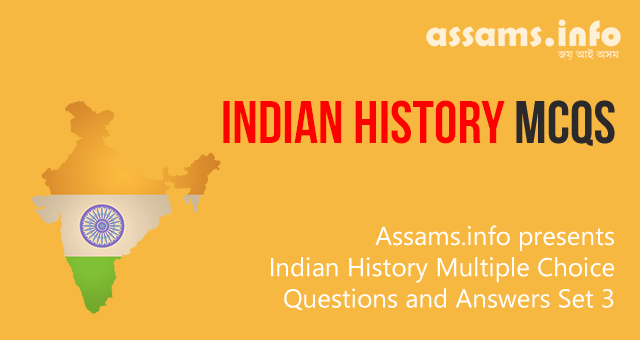Indian History Multiple Choice Questions (MCQs) Set – 3
Indian History Multiple Choice Questions (MCQs) for competitive examinations. This MCQ set contains 20 objective type questions from Modern Indian History topics such as British Rule in India and the Indian Freedom movement. Some of these questions are picked from previous question papers. Just like our previous indian history mcqs, short explanations are provided along with the answers. We hope that student and civil service aspirants will find these questions useful.

MCQs on Modern Indian History
Indian History is one of the important parts of the general studies paper of any competitive examination. Following twenty questions are from Modern History of India.
1. Who among the following attended the first Session of the Round Table Conference in 1930?
- a) M. K. Gandhi
- b) Madan Mohan Malviya
- c) Vallabhbhai Patel
- d) B. R. Ambedkar
Answer: d) B. R. Ambedkar
Bhimrao Ramji Ambedkar attended the first Round table conference representing depressed classes. In fact, Ambedkar attended all three round table conferences.
2. Which of the following Princely states refused to join the Indian Union in 1947?
- a) Jaipur
- b) Mysore
- c) Hyderabad
- d) Travancore
Answer: c) Hyderabad
Three princely states – Hyderabad, Junagadh, Jammu and Kashmir refused to join the Indian Union in 1947.
3. Who among the following moved the first resolution in the first session of Indian National Congress?
- a) Umesh Chandra Banerjee
- b) Mahatma Gandhi
- c) Jawaharlal Nehru
- d) G. Subramania Iyer
Answer: d) G. Subramania Iyer
Social reformer and founder of the Hindu newspaper, Ganapathy Dikshitar Subramania Iyer moved the first resolution in the first session of Indian national congress held in Bombay.
4. For organizing which Satyagraha was Vallabhbhai Patel conferred the title of Sardar?
- a) Kheda Satyagraha
- b) Salt Satyagraha
- c) Individual Satyagraha
- d) Bardoli Satyagraha
Answer: d) Bardoli Satyagraha
Bardoli Satyagraha of 1928 was organised by Vallabhbhai Patel. Due to his organizational skills and ability to mobilize the people, the women of Bardoli gave him the ‘Sardar’ title.
5. During his stay in South Africa, Mahatma Gandhi published a newspaper named
- a) India Gazette
- b) Afrikaner Gazette
- c) Kesari
- d) Indian Opinion
Answer: d) Indian Opinion
Indian Opinion was a a multi-lingual newspaper published from Natal, South Africa. It’s first issue came out on June 6, 1903.
6. Controversial Rowlatt Act was named after Rowlatt, who was a
- a) British General
- b) Judge
- c) Secretary of State
- d) Solicitor General
Answer: (b) Judge
Rowlatt Act was named after British judge Sir Sidney Rowlatt. He was the president of the Rowlatt Committee that prepared the controversial act.
7. Which of the following declared infanticide completely illegal in India?
- a) Bengal Regulation Act, 1795
- b) Charter Act, 1833
- c) Minto-Morley reforms
- d) Sati Regulating Act of 1829
Answer: a) Bengal Regulation Act, 1795
Bengal Regulation Act XXI of 1795 completely banned infanticide in India.
8. The Anglicist-Orientalist controversy during the British East India Company rule of India was related to
- a) revenue
- b) education
- c) trade
- d) railways
Answer: b) Education
The Anglicist-Orientalist controversy was related the education system in India. Anglicists emphasised on English education, while Orientalist supported vernacular education. The controversy ended in victory for the Anglicists when Lord Macaulay’s ‘Minute on Education’ was passed in 1835 and English became the medium of education in India. From Assams.info.
9. Who was the first Indian to become a member of the British House of Lords?
- a) Dadabhai Naoroji
- b) Satyendra Prasanna Sinha
- c) Arun Kumar Sinha
- d) Mancherjee Bhownagree
Answer: b) Satyendra Prasanna Sinha
In 1919, Satyendra Prasanna Sinha became a member of House of Lords, the upper house of British parliament. Later his son Arun Kumar Sinha inherited his seat. Dadabhai Naoroji and Mancherjee Bhownagree were elected to the British house of commons, not house of lords.
18. Aruna Asaf Ali was connected with the underground activities during which one of the following movements?
- a) Civil Disobedience Movement
- b) Non-cooperation Movement
- c) Quit India Movement
- d) Swadeshi Movement
Answer: c) Quit India Movement.
Aruna Asaf Ali was a major woman organizer of underground activity during the Quit India Movement.
19. Who among the following organized a march on the Tanjore Coast to break the Salt Law in April, 1930?
- a) V. O. Chidambaram
- b) K. Kamraj
- c) Annie Besant
- d) C. Rajagopalachari
Answer: d) C. Rajagopalachari
Chakravarti Rajagopalachari led the Vedaranyam March on April, 1930.
20. The Wood’s Despatch of 1854 was related to
- a) Educational reforms
- b) Administrative reforms
- c) Social Reforms
- d) Political reforms
Answer: a) Educational reforms
Sir Charles Wood’s Despatch of 1854 was a written document which contained recommendations to improve education in India. It is said to have laid the foundation of our present system of education.
